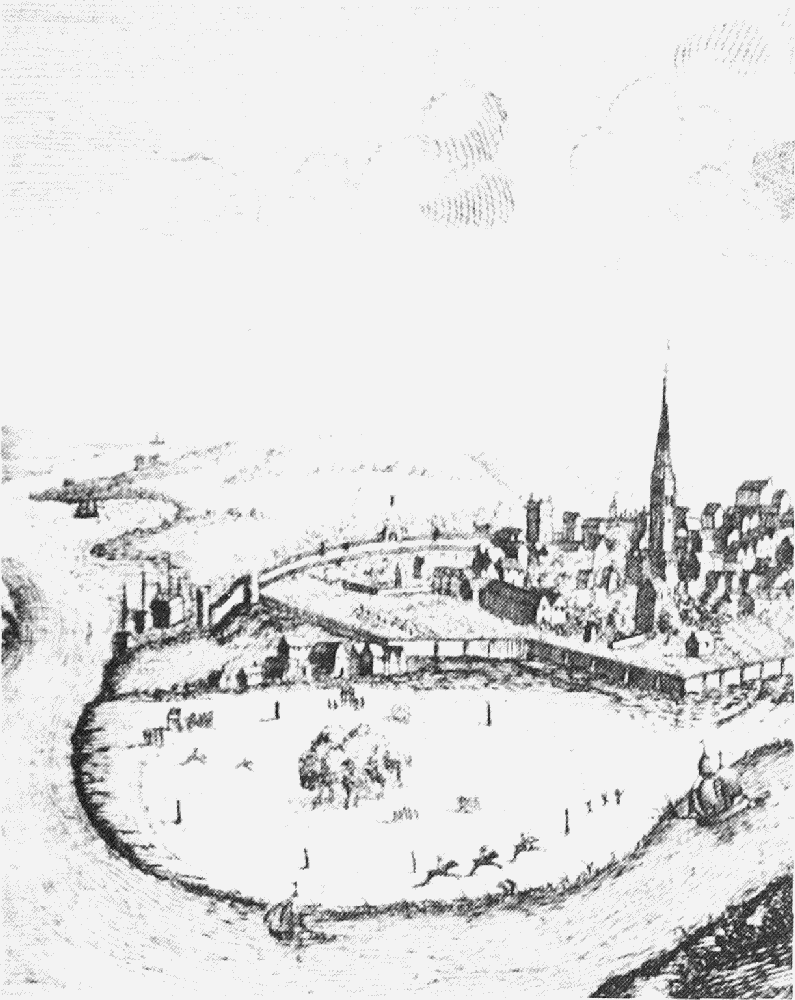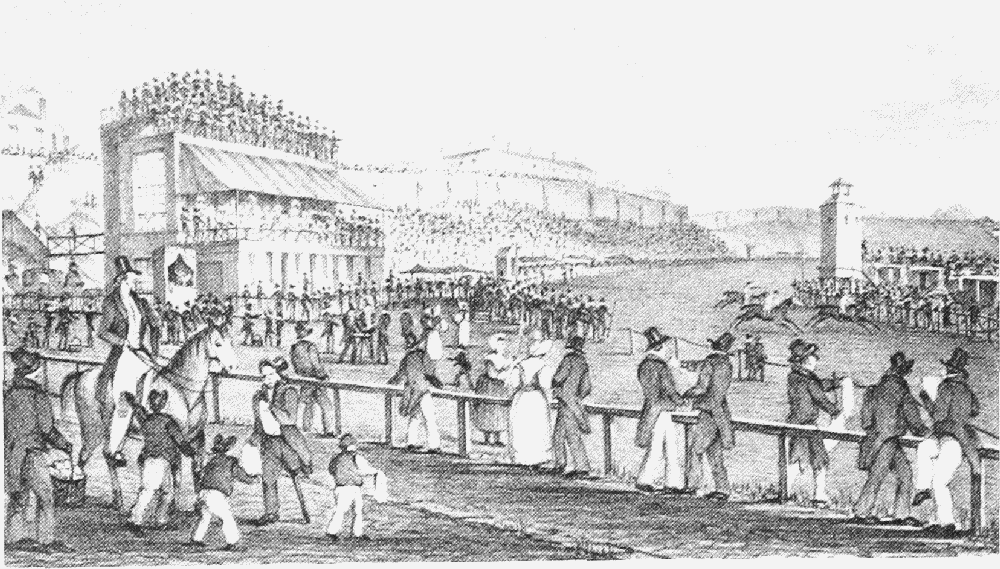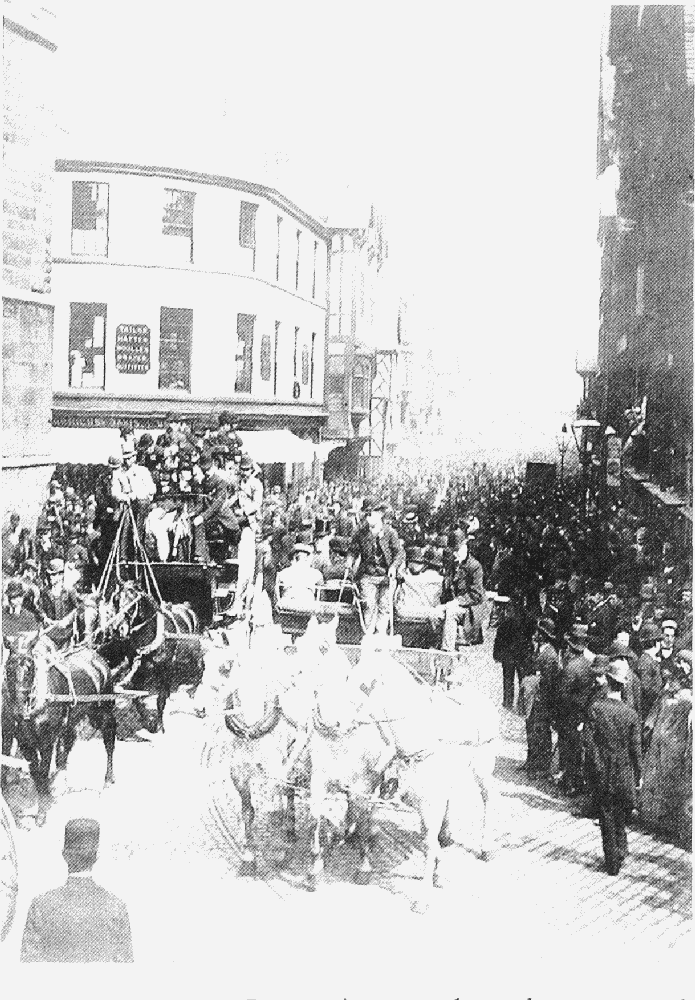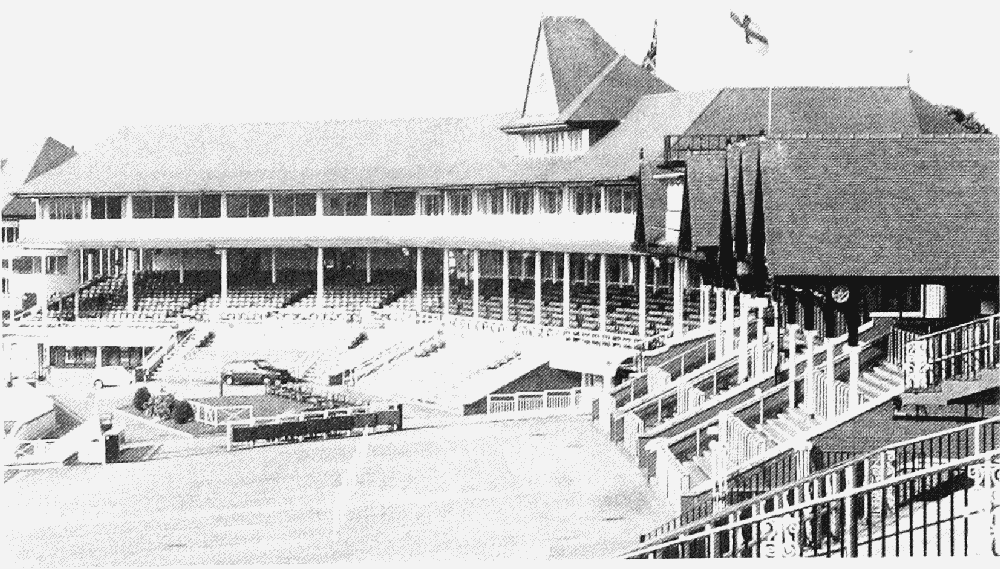A History of the County of Chester: Volume 5 Part 2, the City of Chester: Culture, Buildings, Institutions. Originally published by Victoria County History, London, 2005.
This free content was digitised by double rekeying. All rights reserved.
J S Barrow, J D Herson, A H Lawes, P J Riden, M V J Seaborne, 'Leisure and culture: Chester races', in A History of the County of Chester: Volume 5 Part 2, the City of Chester: Culture, Buildings, Institutions, ed. A T Thacker, C P Lewis (London, 2005), British History Online https://www.british-history.ac.uk/vch/ches/vol5/pt2/pp255-260 [accessed 30 April 2025].
J S Barrow, J D Herson, A H Lawes, P J Riden, M V J Seaborne, 'Leisure and culture: Chester races', in A History of the County of Chester: Volume 5 Part 2, the City of Chester: Culture, Buildings, Institutions. Edited by A T Thacker, C P Lewis (London, 2005), British History Online, accessed April 30, 2025, https://www.british-history.ac.uk/vch/ches/vol5/pt2/pp255-260.
J S Barrow, J D Herson, A H Lawes, P J Riden, M V J Seaborne. "Leisure and culture: Chester races". A History of the County of Chester: Volume 5 Part 2, the City of Chester: Culture, Buildings, Institutions. Ed. A T Thacker, C P Lewis (London, 2005), British History Online. Web. 30 April 2025. https://www.british-history.ac.uk/vch/ches/vol5/pt2/pp255-260.
CHESTER RACES
The race meeting on the Roodee, a 'perfect natural amphitheatre' framed by the river Dee and the city walls, is Chester's best known and longest established sporting event. (fn. 1) Regular races were first organized there in 1540 and have been held almost continuously ever since, interrupted only by civil war and puritanism in the 17th century, (fn. 2) and world war, strikes, and flooding in the 20th. (fn. 3) Continuity on the same racecourse justifies Chester's claim to be the oldest race meeting in the country. (fn. 4) With rare exceptions all the racing has been on the flat.
The original race, run on Shrove Tuesday for a silver bell given by the Saddlers' company, was devised by Mayor Henry Gee as an element in his reformed civic celebrations. It was evidently run only intermittently in the 17th century, (fn. 5) but was still taking place in 1705. (fn. 6) The lessee of the grazing on the Roodee for 1711–13 was required to allow the Shrovetide race to continue to take place, (fn. 7) though it had in fact recently been moved to another day. (fn. 8)
In 1610 a new race on St. George's Day (23 April) was inaugurated by Robert Amery, who gave two silver bells, returnable each year, as prizes. The winner and second also divided the stake money of 20s. a horse between them in the proportions 2:1. The city took control of the event in 1612. (fn. 9) In 1623 the mayor, John Brereton, increased the prize to a cup worth £8 and altered the course (from what form is not known) by moving the start north of the Water Tower and fixing the distance as five laps of the Roodee, (fn. 10) at least five miles in total. The starting stone, 4 yd. from the Water Tower, was still identifiable as a landmark in 1746 even though it was disused by then. (fn. 11)
A description of the races c. 1609 as 'for the public recreation of the whole city' may imply that they then remained primarily part of the annual round of civic ceremonial, (fn. 12) but in the 17th century the St. George's Day race became a 'county' event. As early as c. 1618 the mayor and Assembly were said to be accompanied at the race by 'such other lords, knights, ladies, gentlemen as please'. (fn. 13) In 1665 owners of horses taking part included the Cheshire gentlemen Edward Massey of Puddington and Sir Philip Egerton of Oulton Park. (fn. 14)
In 1640 a further race was started on Easter Tuesday. The prize, given by the city sheriffs, was a piece of silver plate worth £13 6s. 8d. (fn. 15) In 1706 the Shrovetide and St. George's Day races were moved to Easter Tuesday, but two years later all the racing was concentrated at a meeting on St. George's Day, (fn. 16) and the rules under which they were run were codified and confirmed. The principal race was the City Plate, supported by both the corporation and the guilds. Each owner could enter one horse carrying 10 stone. The race started at 2.30 and was apparently run round a right-handed circuit marked out by poles over three heats of three laps each (about three miles), with up to 30 minutes allowed for rubbing down the horses between heats. The prize went to the first horse to win two heats. Any which finished more than 120 yd. behind the winner of a heat did not run again. If three different horses won the heats they ran off in a fourth heat. (fn. 17) New 'chairs', presumably to mark the start and finish and perhaps the 120-yd. distance, were approved by the Assembly in 1714. (fn. 18)
The new rules marked the establishment of a fixed pattern of racing, and the St. George's Day meeting rapidly became a central event in Chester's social calendar. In the early 18th century 'a great concourse of people from all parts' attended, (fn. 19) owners included gentlemen from Cheshire, Liverpool, and Yorkshire, betting was important, and spectators were numerous and partisan. (fn. 20) The corporation long remained intimately involved. In 1694 it reaffirmed an old rule by ordering that horses entered for the races were to be stabled in the city for eight days beforehand (reduced to six days in 1708): the rule served to bring trade into Chester for a few extra days, and also made cheating more difficult because the horses were under supervision for longer. (fn. 21) The corporation was still closely involved in managing the races in 1777, ordering the weight carried by horses to be reduced to 9 stone, and setting the entrance fees for owners and the value of the prizes. (fn. 22)
The racecourse, extended towards the river in 1709, (fn. 23) assumed more or less its modern shape after the canalization of the Dee in the 1730s, when a new timber yard stretching from the Watergate to the river restricted racing to the area south of the Watergate. (fn. 24) The course, changed to a left-handed circuit, as it has remained, was marked by posts and had starting and distance chairs. The corporation viewed the races from a building near the Watergate called the Pentice on the Roodee, perhaps dating from 1607, (fn. 25) and others watched on foot or horseback, or from the city walls, which overlooked the finish. (fn. 26) In 1742 the Assembly required that individuals who wanted to erect booths, tents, or 'standings' against the walls had to seek its special permission first; (fn. 27) and in 1769–70 it built bigger starting and distance chairs, added a balcony to the Pentice, (fn. 28) and gave permission for Bennett Williams of Flint to build a small private grandstand against the city wall. (fn. 29) In 1760 the Assembly had paid a carpenter, Richard Ledsham, for drawing plans for a grandstand but it is not clear that it was built. (fn. 30) In 1777 it decided to charge the owners of carriages 1s. to bring them on the Roodee during the races. (fn. 31) By 1789 the course had been enlarged to make full use of the available ground and there were separate starting chairs for four-yearolds and older horses on the river side, the distance and finishing chairs remaining below the city walls. (fn. 32)

Chester races, 1753
In the early 18th century the meeting lasted three days, each of which featured one race in heats. In each race the first horse to win two heats took the prize, a silver cup or plate given by subscribers. The three plates were worth much the same, especially after 1739, when parliament set a minimum value for prizes, (fn. 33) but the most sought after was the City Plate, by the 1710s provided each year through subscriptions from the corporation and guilds. The distance was increased from three to four laps in 1726. The race was run under different names (St. George's Plate, New Plate, Corporation Plate, and City Purse) until 1836, (fn. 34) when the council realized that the Municipal Corporations Act of 1835 had made its own financial contribution illegal. (fn. 35) The second most highly regarded race in the 18th century was the Grosvenor Gold Cup, first offered by Sir Robert Grosvenor, Bt., in 1741; (fn. 36) the Grosvenors continued to provide prizes throughout the 18th and 19th centuries. (fn. 37)
Race week was moved to the first full week in May after the calendar reform in 1752, allegedly because the mayor, a draper, hoped to sell more summer dresses in warmer weather. (fn. 38) The programme of racing grew steadily in the later 18th century, a fourth day being added in 1751 and a fifth in 1758, with additional meetings held in 1739, 1744, 1754–5, and 1774–81, (fn. 39) testimony to Chester's popularity among racegoers. Owners c. 1730 included leading noblemen and gentlemen from the North-West, such as the Grosvenors, the earls of Derby, and the Williams-Wynns, (fn. 40) and sportsmen from a wider region which included Flintshire, Denbighshire, Shropshire, Staffordshire, Derbyshire, and Warwickshire. By the 1750s and 1760s, as the reputation of the meeting grew, owners were bringing their horses from Yorkshire, Northumberland, Herefordshire, and Gloucestershire, while in 1767 complaints were voiced that the meeting was dominated by 'Newmarket owners' (meaning the richest and most aristocratic owners who could afford to take part in racing at Newmarket, the country's most important racecourse) to the exclusion of northerners. (fn. 41)
The type of racing changed very little before the late 18th century: a race for four-year-olds over two-mile heats was added in 1751, but still in 1790 each day's racing consisted of a single race run in heats. Runners were not numerous: on average only four or five contested each race in the 1740s and 1750s. (fn. 42) The character of the meeting began to change only in the 1790s. Racing in heats was gradually abandoned in favour of races in their modern form, run in a single heat, though matches arranged privately between two owners were important for a time in the early 19th century. Already by 1800 there were as many ordinary races and matches as races in heats; by 1810 heats made up less than a third of the total; and by 1820 ordinary races were the norm. The change came about to accommodate the trend towards running younger horses over shorter distances, testing speed alone and not stamina. Chester had a race for three-year-olds over two miles by 1800, and one for two-year-olds over four furlongs by 1820. In the latter year, of the other ten races four were over a mile, four over two miles, and only two over three miles. The switch to the modern pattern was complete by 1860, when the four-day meeting included twelve sprints of seven furlongs or less, nine races between a mile and two miles, and only two distance races. (fn. 43)

Chester races, between 1830 and 1840
Several new races were introduced in the first third of the 19th century, (fn. 44) notably the Chester Tradesmen's Cup (later called the Chester Cup) in 1824. It was a handicap, something of a novelty and popular among gamblers. Its importance was established by 1836, when it was said that £1 million was wagered on its outcome. Its success also owed much to skilful handicapping by E. W. Topham, clerk of the course from the 1840s to his death in 1873. (fn. 45) During his time it attracted thirty or forty runners. (fn. 46) Once racing in heats had been abandoned there was less need for the meeting to last a full week, and it was reduced to four days in 1843 (though there was an additional October meeting 1843–57), and to three in 1878. (fn. 47)
The Assembly's disengagement from direct management of the races probably dates from around 1798, when it ordered the Pentice on the Roodee to be demolished and ceased attending in its official capacity. (fn. 48) In the early 19th century the races were instead managed by a committee which rented the Roodee from the corporation for a fortnight each year, the first week to allow for preparations. (fn. 49) In 1817, in response to the growing interest of polite society, a public subscription raised £2,500 to build a new grandstand. Among those involved in the grandstand committee were Sir Watkin Williams-Wynn and the local newspaper proprietor John Fletcher. The city's innkeepers, who sold refreshments from tents and booths on the Roodee during the races, were opposed to it but failed to convince the corporation. The grandstand, designed by Thomas Harrison, was opened in 1819 on land leased by the corporation opposite the starting post. Entered from the city walls, it allowed the wealthiest racegoers to seclude themselves from the lower orders, and was enlarged in 1829. (fn. 50) A second subscription stand, the Dee Stand, was put up to its south by a separate company in 1840 and catered for the middle classes. (fn. 51) In the 1820s the social tone of the meeting was evidently high: a sympathetic observer wrote of the 'immense influx of affluent visitors' from Cheshire, Lancashire, Shropshire, and Wales during race week. (fn. 52)
Several factors might have curtailed racing during the 19th century. The switch to sprints put Chester at a disadvantage. The circuit was so tight that even fivefurlong races could not be run on the straight, and owners of valuable young bloodstock were reluctant to enter them in races where they might be injured. (fn. 53) There was also growing opposition on moral grounds, especially from the city's nonconformists and evangelicals. In 1856 William Wilson inveighed against the races, which he asserted brought drunkenness, brawling, gambling, theft, prostitution, 'loathsome diseases', lunacy, suicide, and damnation to the city. (fn. 54) The attack was renewed in more measured tones in 1870–1 by the Anglican establishment, led by Dean Howson and Canon Kingsley, (fn. 55) and in 1898 by the Evangelical Free Church Council. (fn. 56)
The stridency of Wilson's attack in 1856 is evidence that the race meeting had assumed a popular character on top of its long-standing appeal to the gentry. The railways were thought to have tripled attendance by 1850, (fn. 57) and as working-class leisure became more ample the crowds grew ever larger. Race week, especially Chester Cup day, was regarded in 1876 as 'a people's holiday' and 'one of the great sporting holidays of the North'. The size of crowds at open meetings before 1893 is difficult to estimate but they were clearly very large: the figure of 100,000 said to have attended on Cup Day in 1886 perhaps represents a wild guess, and a different observer writing in 1892 thought that the attendance was normally about 50,000. (fn. 58)
The third factor was unsatisfactory management. From 1840 there were three bodies with separate financial interests as lessees from the city: the Race Course Committee, the Grand Stand Committee, and the Dee Stand Committee. The stand proprietors were believed to make huge profits, (fn. 59) most of which they in fact ploughed back into the races as prize money. (fn. 60) At first the council remained at arm's length, taking a closer interest from the 1880s as pressure mounted to modernize both the meeting and the course. Its Roodee committee (later called the racecourse committee), set up in 1884, sought to fend off demands that the meeting be stopped altogether, and to make new arrangements after the grandstand leases expired. (fn. 61) In 1888 the issue was forced by the Race Course Co.'s declaration that it would not renew its lease when it expired in 1892. Negotiations among the parties directly interested, the Jockey Club, and the promoters of a new racecourse elsewhere made it clear that many wanted to turn Chester into a gate-money meeting, following the national trend among the surviving 'county' race meetings. The agreement that finally emerged owed much to Alderman H. T. Brown, chairman of the racecourse committee, who outflanked the anti-racing lobby by offering only a 14-year lease and one race meeting a year, not the 25 years and two meetings which the promoters wanted. (fn. 62) Opposition to racing lingered into the 1920s (fn. 63) but its force was broken by the tighter regulation of crowds made possible by the reorganization of 1893. The existing company reformed itself as the Chester Race Co. in 1892, bought out the stand proprietors, and held the first 'closed' meeting, charging for admission, in 1893.
Admission charges at first reduced attendance to 20,000 on Cup Day 1893, but numbers soon rose again and from 1900 fully justified the description of 'gigantic throngs of humanity' clogging the streets of Chester and queueing for admission from the Roodee the full length of Watergate Street to the Cross. New heights were reached after both world wars: 96,000 went racing on Cup Day 1920, 104,000 in 1946. (fn. 64) The races were still thought of as 'the great Cheshire holiday' in 1951, (fn. 65) but wider opportunities for leisure from the later 1950s quickly eroded the crowds. An evening meeting which drew 17,000 in 1974 was thought remarkable, (fn. 66) and the daily average in 1995 was c. 14,000. (fn. 67)

Race-going crowds at the Cross and Eastgate Street, c. 1903
The crowds necessitated new facilities after 1893. At first there were only minor additions, such as a press box and telegraph office in 1894, and the company proposed merely to improve the existing stands, but the council's racecourse committee pressed for new stands meeting current standards and expectations. Thus was completed in 1900 the County Stand, a picturesque half-timbered building designed by Mangnall & Littlewoods of Manchester to accommodate 5,000 people under cover. (fn. 68) Its loss by fire in 1985 was much lamented, and in 1988 it was replaced by a new stand with improved facilities (Fig. 159, p. 260). (fn. 69)
More races were added to the programme after the 1893 reorganization, notably the Chester Vase in 1907, (fn. 70) but the Chester Cup retained its primacy, especially c. 1900, (fn. 71) and again in the 1930s, when it was regarded as a trial for the Derby. (fn. 72) Chester was slow to increase the number of days' racing in the 20th century, and in 1951 was one of only two flat courses with a single meeting each year. (fn. 73) Chester was awarded three extra days and an evening meeting in 1964; another evening meeting was added in 1987, a further two days in 1990, and a Sunday meeting before 1995, by when there were 11 days of racing between May and October each year. (fn. 74)

New grandstand, built 1988